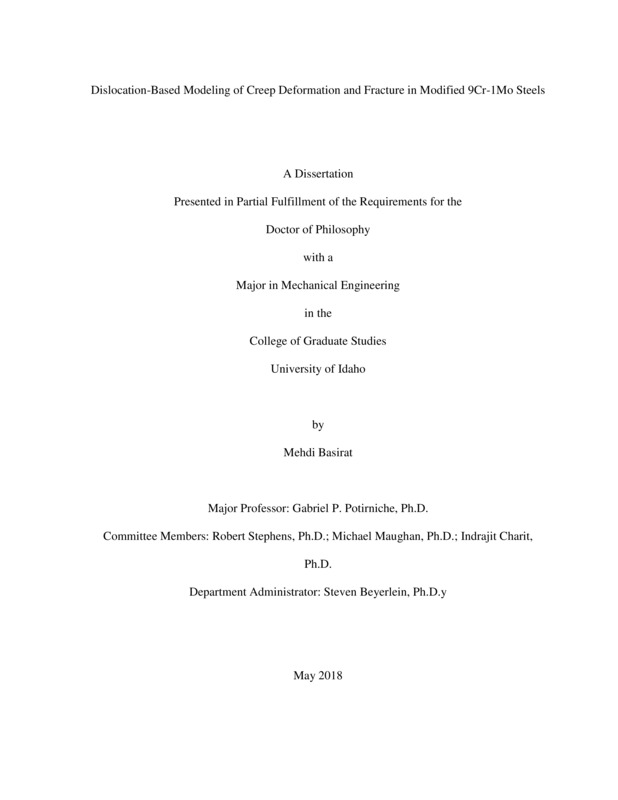Dislocation-Based Modeling of Creep Deformation and Fracture in Modified 9Cr-1Mo Steels
Basirat, Mehdi. (2018-03). Dislocation-Based Modeling of Creep Deformation and Fracture in Modified 9Cr-1Mo Steels. Theses and Dissertations Collection, University of Idaho Library Digital Collections. https://www.lib.uidaho.edu/digital/etd/items/basirat_idaho_0089e_11321.html
- Title:
- Dislocation-Based Modeling of Creep Deformation and Fracture in Modified 9Cr-1Mo Steels
- Author:
- Basirat, Mehdi
- Date:
- 2018-03
- Keywords:
- 9Cr-1Mo abaqus creep Damage Dislocation density UMAT
- Program:
- Mechanical Engineering
- Subject Category:
- Mechanical engineering
- Abstract:
-
The very high-temperature reactor (VHTR) represents the next generation of high temperature gas-cooled reactors designed for the future nuclear power plants. The VHTR is operated at higher pressure and temperature for longer time compared with the Pressurized Water Reactors (PWRs). Modified 9Cr-1Mo steel is a suitable candidate material for VHTR pressure vessels. Although 9Cr-1Mo steel has good creep resistance, its microstructure degrades during manufacturing processes such as welding or high temperature operation. Hence, investigating the creep resistance of welded 9Cr-1Mo steel is crucial.
In this research, a micromechanical model is developed for the evaluation of creep deformation and rupture times of modified 9Cr-1Mo steel specimens. Creep deformation in metals is generally induced by dislocation generation, motion, and annihilation. Evolution of the dislocation density was modeled by considering the generation and annihilation of single and dipole dislocations. In addition to dislocation motion, there are several other factors which determine the creep resistance of this steel. Among these, the most significant are precipitate coarsening, solid solutions depletion, and void/crack nucleation and growth. The evolution of these mechanisms was accounted for by introducing specific continuum damage terms.
In this study a one-dimensional (1-D) model was successfully applied to specimens made of the as-received 9Cr-1Mo steel. Comparison of the numerical model results with experimental data showed satisfactory agreement. However, a 1-D model has several limitations including applicability limitation to only 1-D stress state problems, and the inability of studying components made of more than one material. Therefore, developing a three-dimensional (3-D) comprehensive model is required to meet the objective of this research which was the prediction of creep life in welded joints made of modified 9Cr-1Mo steel. The developed 1-D model was modified and implemented in the commercial finite element software ABAQUS by means of a User Material Subroutine (UMAT). The creep of welded 9Cr-1Mo specimens was simulated by considering different material behavior in the heat affected zone (HAZ) and the welded material. Several creep experiments were conducted on 9Cr-1Mo welded specimens. The tensile creep tests were performed at a temperature range of 550-700 ˚C and stress level of 80-200 MPa. Finally, simulation results were compared to experiments, and excellent agreement was obtained between experiments and simulations.
- Description:
- doctoral, Ph.D., Mechanical Engineering -- University of Idaho - College of Graduate Studies, 2018-03
- Major Professor:
- Potirnicche, Gabriel P
- Committee:
- Stephens, Robert; Maughan, Michael; Charit, Indrajit
- Defense Date:
- 2018-03
- Identifier:
- Basirat_idaho_0089E_11321
- Type:
- Text
- Format Original:
- Format:
- application/pdf
- Rights:
- In Copyright - Educational Use Permitted. For more information, please contact University of Idaho Library Special Collections and Archives Department at libspec@uidaho.edu.
- Standardized Rights:
- http://rightsstatements.org/vocab/InC-EDU/1.0/

